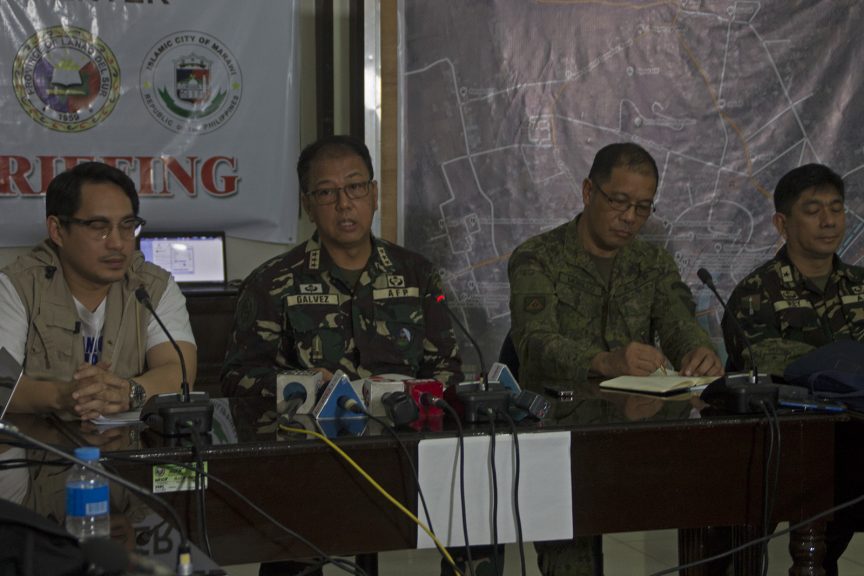 ALMOST OVER? Portions of Marawi City near Lake Lanao burn after an aerial bombardment on Monday (October 9, 2017). Military officials declared the siege will end this month. MindaNews photo by H. MARCOS C. MORDENO
ALMOST OVER? Portions of Marawi City near Lake Lanao burn after an aerial bombardment on Monday (October 9, 2017). Military officials declared the siege will end this month. MindaNews photo by H. MARCOS C. MORDENO
MARAWI CITY (MindaNews/09 October) — Military operations against the ISIS-inspired militants in this besieged city have resulted not just in hundreds of casualties and massive destruction due to intense close quarter battles and aerial bombardment but have also been marked by unmet, self-imposed deadlines.
The siege started on May 23, and despite their edge in numbers and firepower Philippine security forces have time and again failed to meet several deadlines to decimate the militants or drive them out of Marawi.
On Monday last week, Western Mindanao Command’s Lt. Gen. Carlito Galvez Jr. predicted that the siege will end in 15 days.
Last August 28, the same official had said that they will wrap up the conflict in two to three weeks.
Armed Forces Chief of Staff General Eduardo Ano, in a press conference in Cagayan de Oro City on June 11, said “konting pasensiya na lang” (just a little patience) was needed.
Military spokespersons had issued similar statements to reporters during briefings at the Lanao del Sur provincial capitol complex.
During the press briefing Monday, two days before his latest deadline would lapse, Galvez expressed confidence it could be done.
“Yong 10-15 days natin, I believe mahabol natin (we can meet it),” he said.
The militants however continued to keep government forces at bay, a fact attributed by military officials to the presence of hostages and civilians trapped in the battle zone.
 Lt. Gen. Carlito Galvez Jr. (2nd from left), Western Mindanao Command chief, airs optimism on Monday (October 9, 2017) that the Marawi siege will end this month. MindaNews photo by H. MARCOS C. MORDENO
Lt. Gen. Carlito Galvez Jr. (2nd from left), Western Mindanao Command chief, airs optimism on Monday (October 9, 2017) that the Marawi siege will end this month. MindaNews photo by H. MARCOS C. MORDENO
Col. Romeo Brawner, deputy commander of Joint Task Group Ranao, on Saturday said their assaults have been slowed down by their policy to avoid civilian casualties.
But since May 25 the military has been employing aerial and artillery bombardment, a tactic that one reporter noted appears to contradict such policy.
The reporter was hinting that the daily bombing runs could have either killed or injured civilians in the battle zone.
With its current technology, accuracy is not something the Philippine Air Force could guarantee. In fact, a number of government troops were killed by “friendly fire” in two instances.
But since it’s difficult to retrieve cadavers from the battleground all of them were recovered after they had decomposed, making it impossible to know if civilians were hit by the bombings, too.
Meanwhile, government casualties continued to rise. As of Sunday, 158 soldiers and police had been killed in action. Over a thousand others have been wounded.
Galvez said Monday that 774 militants had been killed.
Brawner said on Saturday that 38 to 48 militants were still holding their positions with the aid of improvised explosive devices.
He added that some soldiers had contracted dengue, typhoid fever and other viral diseases.
The siege has entered its fifth month, and despite repeated assurances that it will end soon the signs point to the likelihood of the conflict dragging on longer than expected or hoped for.
The military admitted it’s fighting a brand of conflict — urban warfare — in which it has neither training nor experience. The Philippine military specializes in jungle warfare.
Nonetheless, Armed Forces Chief of Staff General Eduardo Ano was hoping the siege would end before he retires this month.
On Friday, Ano visited troops at the main battle zone where he was shown the “rat holes” or drainage tunnels that the militants had used as shelters and escape routes during bombings and ground assaults by government forces.
Some of these tunnels were built by the Americans during their colonization of the islands. (H. Marcos C. Mordeno/MindaNews)
